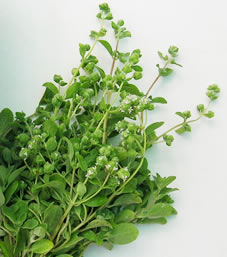Marjoram
Dill
Absinthe
Basil
Borage
Calamint
Capers
Chervil
Coriander
Tarragon
Chives
Wild fennel
Lavender
Lovage
Lippia Citriodora
Marjoram
Lemon balm
Mint
Myrtle
Oregano
Chilli pepper
Salad burnet
Parsley
Rosemary
Garden rocket
Rue
Sage
Celery
Thyme
Valerian
HISTORICAL HINTS: Greeks believed marjoram to be a gift by Aphrodite so they associated it with the idea of happiness. During the Middle Age it was grown in European kitchen gardens. According to the tradition, rubbing its leaves on parquet and furniture make the wood bright, while leaves and flowers in cloth bags make the linen perfumed.
THE PLANT - Marjoram (Origanum majorana L.) is originally from northern Africa and it is an herbaceous perennial plant of the deserted areas (it requires sunlight and sandy soils) belonging to the Labiatae family. In Italy it is used as an aromatic plant since it is has a thyme-like smell but sweeter and more perfumed, very similar to oregano too.
Marjoram can reach 60 cm of height, and has very erected and ramified stems which are woody at the base and herbaceous on top with white-greenish small, oval, hairy leaves. Its whitish and tubular flowers grow around a green centre, while fruits are composed of 4 oval and smooth capsules which are yellow at the beginning and brown as they mature.
Marjoram is one the most used aromatic herbs in Europe; flowered tops and leaves are picked in August, the flowering period, and are dried in bunches which are hung in ventilated and shadow places.
Marjoram leaves, whose aroma becomes more intense when dried, must be stored, as inflorescences, in glass or ceramic pots in dry and cool places
.
PROPERTIES - Marjoram, very used in the past times for its therapeutic properties, is useful to calm states of anxiety, fear, uncertainty, pain and insomnia thanks to its sedative, antispasmodic and tonic-stimulating qualities. It is also recommended to relieve from neuralgia and headache; it is antiseptic, diuretic, expectorant, and anticatarrhal. The flowered tops stimulate gastric secretion helping the digestive process, attenuate painful intestinal contractions, block intestinal fermentation and eliminate gases.
Marjoram is used for antirehumatic rubbing for external use.
CULINARY USE - Marjoram is very used, both dried and fresh, in all those dishes requiring a strong and sweet aroma at the same time: in fact, it is sweeter and more spiced than oregano which is fresher and sharper. It is the ideal herb for pizza, meat, stuffings, meatballs, salty pies, mushrooms, legumes, sauces, mixed salads or tomatoes salads, cheese, shellfish and aromatic vinegars and oils. Marjoram is very used in the Mediterranean cuisine and to prepare a lot of herb-based liqueurs and vermouth, as in the industrial preparation of preserves and food. Fresh flowered tops go with meat, steaks, stew and 'pizzaiola' meat.























